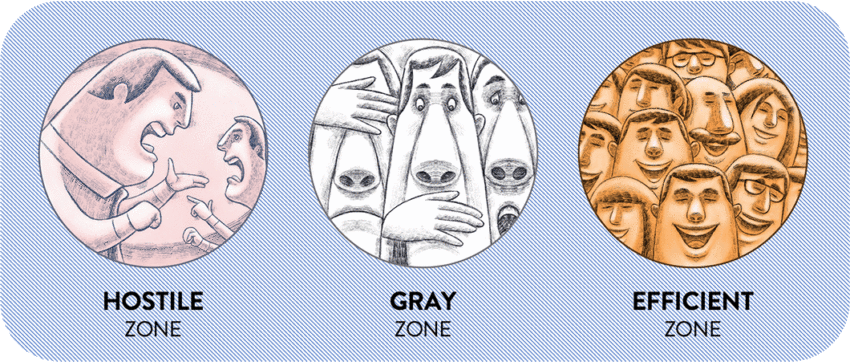A Leadership Guide to Mastering The 3 Zones of Office Politics
The Joys of Office Politics

Office politics seem to be an essential part of any organization. And those that can achieve their desired results in an environment where people have competing interests, have mastered their political landscape.
The goal of this article is to give you insight into how to recognize and navigate through the 3 zones of office politics.
After reading this article, you will have a better understanding of how to engage with others to achieve your workplace goals through the use of positive office politics.
The 3 Zones of Office Politics

Office Politics can be categorized into three zones: Hostile, Gray, and Efficient.
Each of these zones represents an area within the organization where people have competing interests. And to navigate through these zones, you need to understand their characteristics and particular challenges.
Let’s take a look at each zone in detail:
Hostile Zone

Characteristics: Resistant, Self-serving, Emotionally-driven, Lack of trust
Situation: In this zone, expect there to be resistance when trying to align on a common goal.
Pre-Alignment Strategy: Identify the individuals that may have issues with your proposal and aim to resolve their concerns before the meeting.
Mindset: Use objective thinking to ask guided questions to identify the source of contention to help shape a path forward.
Navigation Tips:
- Understand the why: Look at the issue from the other person’s perspective. Take time to understand why there is resistance.
- Maintain your calm: Control your own emotions and maintain a positive attitude. Resist the desire to engage in a heated debate.
- Pick your battles: If the conversation has taken a turn for the worse, try to deescalate and work towards an amicable solution. Based on the situation, it may be wise to strategically concede.
Caution: You must control your emotions in this zone. Engaging in heated debt will only escalate the situation. Also, only concede if you see the strategic value. If not, make sure you objectively document your point of view and escalate to the next level. If you are unable to get your point across, it is best to let it go.
Gray Zone

Characteristics: Accommodating, Hesitant, Cautious
Situation: In this zone, there is an opportunity to reach a mutual consensus if everyone is willing to keep an open mind and make objective decisions.
Pre-Alignment Strategy: Review your plans with key decision-makers before the meeting. Get their buy-in and support, making adjustments to your plan as needed. If done correctly, you would have orchestrated a common solution that everyone is aligned with.
Mindset: Think logically and passionately as you outline a plan that achieves our partner goals while ensuring your objectives are being met.
Navigation Tips:
- Make their needs top priority: Help drive the conversation by starting with a simple question, How can I help you?”. Showing that you care about their needs will build a level of trust and open-mindedness.
- Active-listening: Make an effort to understand the other person’s point of view. The key is to ensure they know their concerns are being heard and addressed.
- Give-and-take: Identify and align with the person’s objectives to define a reasonable solution. This is the quickest path towards a compromise.
Caution: This zone can be tricky to navigate through. You need to be socially aware to understand the individual’s intent. If you push your agenda too hard, this will cause the situation to escalate sending you on a fast track to the Hostile zone.
Efficient Zone

Characteristics: Mutually beneficial, Trust, Collaborative
Situation: In this zone, you have the maximum potential for collaboration opportunities.
Pre-Alignment Strategy: Work with your strategic partners to align on a direction before the meeting. If done correctly, you would have orchestrated a common solution that everyone is aligned with.
Mindset: Adapt your communication style based on the situation. Use objective thinking to provide direction and emotional thinking to communicate your vision with passion.
Navigation Tips:
- Practice Emotional Control: Make sure to focus on understanding how your actions may impact or influence your environment.
- Be Present: Use frequent check-ins to monitor the relationship with your colleagues to continue building trust and ensure the ways of working stay efficient.
Caution: It is easy to become complacent in this zone. Check-in frequently with partner teams as new players will always enter this zone and challenge the status quo. If you are unable to adapt, you could find yourself back in the Gray or Hostile zones.
Wrapping up

The key to succeeding in positive office politics is dependent on your ability to:
- recognize which zone you are in
- learn how best to control your emotions,
- and manage the emotional expectations of others.
Mastering these techniques will help drive positive behaviors that are designed to encourage others by defining common goals that help both the organization and the people involved.
Good luck 🙂






